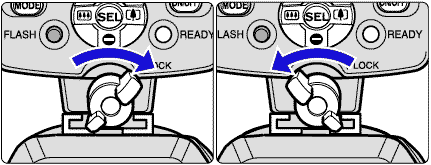 |
Turn the mounting foot lock lever securely until it stops. To lock the Speedlight in place when slot the flash to the camera's accessory shoe, turn the lock lever approx. 90° clockwise until it stops. To unlock, turn the lever counterclockwise until it stops. |
Adjust the flash head. Warning indication: If the flash head is not adjusted to the horizontal/front position, when the power is turned on, this warning appears on the LCD panel.
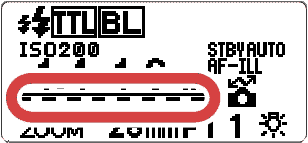 |
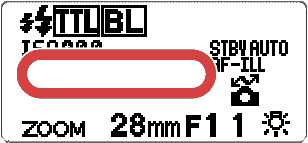 |
A dotted line below the under bar appears when the flash head is tilted down -7°. The flash shooting distance range disappears if the flash head is adjusted to other than the horizontal/front or down -7° position. |
ISO sensitivity: As flash shooting distance range on the SB-800ís LCD panel varies, depending on the ISO sensitivity. Therefore, be sure to set the ISO sensitivity correctly. For cameras compatible with CLS, digital SLRs not compatible with CLS and cameras in Groups I to II, the ISO sensitivity is automatically set and appears on the LCD panel when the camera and SB-800 are turned ON. The SB-800ís maximum ISO sensitivity range usable in the TTL auto flash mode is ISO 25 to 1000.
Setting the ISO sensitivity for cameras in Groups III to VII (New FM2 (FM2n), FM10, FE10, F3-Series, F/N55-Series) -601/N6006, F-601M/N6000 - For cameras in Groups III to VII, set the ISO sensitivity in the Custom settings mode.
1 Turn the SB-800 off
once, then turn it back on. After that, turn on the camera body. 2 Press the
![]() button for approx. 2 sec. to display the Custom settings mode. 3 Press
the
button for approx. 2 sec. to display the Custom settings mode. 3 Press
the ![]() /
/![]() button and
button and ![]() or
or ![]() button to
select ìISOî, then press the
button to
select ìISOî, then press the ![]() button. 4 Press the
button. 4 Press the ![]() /
/![]() button to highlight
the preferred ISO sensitivity.
button to highlight
the preferred ISO sensitivity.
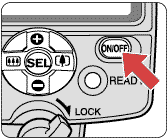 |
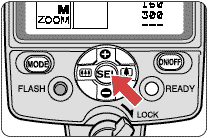 |
 |
 |
The power zoom function When the SB-800 is used with cameras compatible with CLS, digital SLRs not compatible with CLS and cameras in Groups I to II in combination with a CPU lens, the power zoom function activates and the zoom head is automatically adjusted. The guide number indicating flash output level varies according to the zoom-head position. The zoom-head position is automatically adjusted within the range of 24mm, 28mm, 35mm to 105mm in increments of 5mm between 35mm and 105mm when the power zoom function is activated.
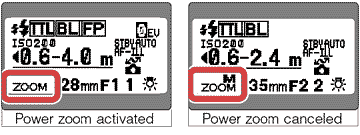 |
When the lens focal length is not one of those indicated above, the zoom head adjusts to the closest wideangle setting of the lens in use. For example, if the zoom setting of a CPU lens is between 36mm and 39mm, the zoom-head position is adjusted to 35mm. If a small M does not appear above the ìZOOMî indication on the LCD panel, the zoom head position will be automatically adjusted. If a small M appears, press the |
Setting the zoom-head position manually
When the SB-800 is
used with cameras in Groups III to VII in combination with a non-CPU lens, or you
want to change the zoom-head position to one that does not match the focal length,
you should adjust the zoom-head position manually. Press the ![]() button to move
toward
button to move
toward ![]() wideangle setting and to move toward a telephoto setting. A small M
above the ìZOOMî indication appears on the LCD panel while manually setting the
zoom-head position. When the camera/lens combination is compatible with the power
zoom function, the zoom-head position changes as follows, when a 35mm lens is attached:
M24mm
wideangle setting and to move toward a telephoto setting. A small M
above the ìZOOMî indication appears on the LCD panel while manually setting the
zoom-head position. When the camera/lens combination is compatible with the power
zoom function, the zoom-head position changes as follows, when a 35mm lens is attached:
M24mm ![]() M28mm
M28mm ![]() 35mm
35mm ![]() M50mm
M50mm ![]() M70mm
M70mm ![]() M85mm
M85mm ![]() M105mm. Generally, set the zoom-head position to the focal length
of the lens in use or to the closest wideangle setting. For example, select the 50mm
setting when using a 60mm lens.
Note: The power zoom function
can be canceled in the Custom settings mode When the power zoom function is canceled,
the zoom-head can be manually adjusted, but the zoom-head position indicator does
not change even if the lens is zoomed, a lens is changed, or the button is pressed.
When the power zoom function is canceled, a small appears on the LCD panel. Press
the mode button to move toward a wideangle setting and the
M105mm. Generally, set the zoom-head position to the focal length
of the lens in use or to the closest wideangle setting. For example, select the 50mm
setting when using a 60mm lens.
Note: The power zoom function
can be canceled in the Custom settings mode When the power zoom function is canceled,
the zoom-head can be manually adjusted, but the zoom-head position indicator does
not change even if the lens is zoomed, a lens is changed, or the button is pressed.
When the power zoom function is canceled, a small appears on the LCD panel. Press
the mode button to move toward a wideangle setting and the ![]() button to move
toward a telephoto setting. The zoom-head position changes as follows: 24mm
button to move
toward a telephoto setting. The zoom-head position changes as follows: 24mm ![]() 28mm
28mm ![]() 35mm
35mm ![]() 50mm
50mm ![]() 70mm
70mm ![]() 85mm
85mm ![]() 105mm
105mm
Built-in wide-flash adapter/Nikon
Diffusion Dome Use the built-in wide-flash adapter when a 14mm to 23mm lens is
mounted. The power zoom function becomes inactive when using the wide-flash adapter.
Press the ![]() or
or ![]() button to
adjust the zoom-head position to 14mm or 17mm. The zoom-head position is automatically
set at 14mm when the Nikon Diffusion Dome is attached. To adjust the zoom-head position
automatically using the power zoom function while using the built-in wide-flash adapter
or Nikon Diffusion Dome, go to the Custom settings ìPower zoom function using the
built-in wide-flash adapter/Nikon Diffusion Domeî. Generally, when using a 14mm or
17mm lens, the distance between the camera and subject differs much from the center
of the frame to the periphery, so the peripheral area might not be sufficiently lit
in some cases. The same is true when using the Nikon Diffusion Dome.
button to
adjust the zoom-head position to 14mm or 17mm. The zoom-head position is automatically
set at 14mm when the Nikon Diffusion Dome is attached. To adjust the zoom-head position
automatically using the power zoom function while using the built-in wide-flash adapter
or Nikon Diffusion Dome, go to the Custom settings ìPower zoom function using the
built-in wide-flash adapter/Nikon Diffusion Domeî. Generally, when using a 14mm or
17mm lens, the distance between the camera and subject differs much from the center
of the frame to the periphery, so the peripheral area might not be sufficiently lit
in some cases. The same is true when using the Nikon Diffusion Dome.
SB-800ís available flash modes The SB-800ís available flash modes vary, depending on the cameras and lenses in use or the cameraís exposure mode. Using the TTL auto flash mode is recommended for normal flash photography.
TTL auto flash mode |
 |
TTL auto flash modes available with the SB-800 The available types of TTL auto flash vary, depending on the camera/lens/exposure mode/metering system in use. The following tables show the SB-800ís TTL mode indicators and the corresponding ones used in the current Speedlight manuals when the flash unit is used with various cameras not compatible with CLS. |
Cameras compatible with the TTL/D-TTL auto flash mode
Monitor Preflashes The
SB-800 fires a series of imperceptible Monitor Preflashes just before the flash fires
to obtain information on the subject in these cases: (1) when the SB-800 is used
with cameras compatible with CLS, digital SLRs not compatible with CLS, and cameras
in Group I with a CPU lens, and the flash mode is set to TTL auto flash, and (2)
when the SB-800 is used with cameras compatible with CLS with a CPU lens, and the
flash mode is set to Auto Aperture flash. Monitor Preflashes are fired instantaneously
and cannot be differentiated from the main flash, but ![]() appears
on the LCD panel (using a single flash unit). However, for cameras in Group I, Monitor
Preflashes are not fired when the SB-800ís flash head is adjusted to other than the
horizontal/front or down to -7° position, or the cameraís flash sync mode is
set to Rear-curtain sync, even when
appears
on the LCD panel (using a single flash unit). However, for cameras in Group I, Monitor
Preflashes are not fired when the SB-800ís flash head is adjusted to other than the
horizontal/front or down to -7° position, or the cameraís flash sync mode is
set to Rear-curtain sync, even when ![]() appears on the LCD
panel.
appears on the LCD
panel.
Setting and Selecting the SB-800ís
flash mode 1 Press
the ![]() button to set the flash mode. ï Display
button to set the flash mode. ï Display ![]()
![]() on the LCD panel.
2 Confirm that the main subject is within the flash shooting distance range.
on the LCD panel.
2 Confirm that the main subject is within the flash shooting distance range.
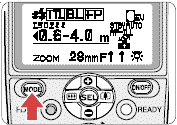 |
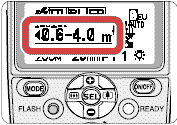 |
Every time
you press the |
 |
The SB800's flash working / distance range The SB-800ís flash shooting distance range is 0.6m to 20m (2 to 66 ft.) and varies, depending on the ISO sensitivity, zoom-head position, and lens aperture in use. |
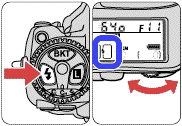 |
Confirm & Set the cameraís flash sync mode to Front-curtain sync before you shoot. With cameras featuring a Rear-curtain sync flash mode, make sure the cameraís flash sync mode is set to Front-curtain sync. Note: For other flash sync modes, refer to ìSlow-sync flash, ìRed-Eye reduction with slow-sync flash modeîor ìRear-curtain syncî. Always refer to the cameraís instruction manual for details on the availability of working flash sync mode of that camera model. |
If the ready-light blinks after shooting, the light might be insufficient for correct exposure. In the TTL auto and Non-TTL auto flash modes, when the flash has fired at its maximum output and underexposure may have occurred, the ready-lights on the SB-800 and in the cameraís viewfinder blink for approx. 3 sec. Depending on the camera in use, the ready-light on the SB-800 or in the cameraís viewfinder lights up. To compensate, use a wider aperture or move closer to the subject and reshoot.
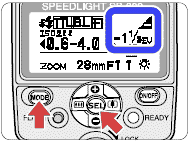 |
Display of the amount of underexposure For cameras compatible with CLS, digital SLRs not compatible with CLS and cameras in Group I in the TTL auto flash mode, the amount of underexposure (0 to -3.0 EV) appears for approx. 3 sec on the SB-800ís LCD panel; at the same time the above ready-lights blink. Pressing the |
TTL auto flash mode: In this mode, the flash illumination that is reflected back from the subject is detected by the cameraís TTL auto flash sensor and the camera automatically controls the flash output level to give the correct exposure.
![]()
![]() Automatic Balanced Fill-Flash: Press the
Automatic Balanced Fill-Flash: Press the ![]() button to display TTL/BL
on the LCD panel, and Automatic Balanced Fill-Flash is performed. The flash output
level is automatically adjusted for a well-balanced exposure of the main subject
and background. (While performing Balanced Fill-Flash, no
button to display TTL/BL
on the LCD panel, and Automatic Balanced Fill-Flash is performed. The flash output
level is automatically adjusted for a well-balanced exposure of the main subject
and background. (While performing Balanced Fill-Flash, no ![]() appears with cameras
in Groups III and IV.) Note:
appears with cameras
in Groups III and IV.) Note: ![]()
![]() indicates ìi-TTL
Automatic Balanced Fill-Flashî in the i-TTL mode.
indicates ìi-TTL
Automatic Balanced Fill-Flashî in the i-TTL mode.
![]() Standard TTL flash: Press the
Standard TTL flash: Press the ![]() button to display
button to display ![]() on the LCD panel,
and Standard TTL flash is performed. The main subject is correctly exposed regardless
of the background brightness. This is useful when you want to highlight the main
subject. Note:
on the LCD panel,
and Standard TTL flash is performed. The main subject is correctly exposed regardless
of the background brightness. This is useful when you want to highlight the main
subject. Note: ![]() indicates ìStandard i-TTL flashî in the i-TTL mode,
ìStandard TTL flash for Digital SLRsî in the D-TTL mode, and ìStandard TTL flashî
in the TTL (film-based) mode.
indicates ìStandard i-TTL flashî in the i-TTL mode,
ìStandard TTL flash for Digital SLRsî in the D-TTL mode, and ìStandard TTL flashî
in the TTL (film-based) mode.
Flash shooting in the 1/300 TTL High-Speed Flash sync mode (Nikon F5 only and/or other applicable Nikon bodies in the future) The farthest flash shooting distance cannot be read on the SB-800ís LCD panel. In this case, use the guide number table and equation for calculating this distance, according to each zoom-head position.
Non-TTL auto flash mode
![]() Auto Aperture flash The SB-800ís built-in sensor
measures the flash illumination reflected from the subject and controls the flash
output in combination with data automatically transmitted from the camera and lens
to the SB-800, including the ISO sensitivity value and exposure compensation value
as well as the aperture and focal length of the lens. Note: Auto Aperture flash is
available with cameras compatible with CLS, digital SLRs not compatible with CLS,
and cameras in Groups I and II when used with a CPU lens. Auto Aperture flash is
automatically set (default setting) for the above camera/lens combinations. To cancel
Auto Aperture flash and set to Non-TTL auto flash, use Custom settings.
Auto Aperture flash The SB-800ís built-in sensor
measures the flash illumination reflected from the subject and controls the flash
output in combination with data automatically transmitted from the camera and lens
to the SB-800, including the ISO sensitivity value and exposure compensation value
as well as the aperture and focal length of the lens. Note: Auto Aperture flash is
available with cameras compatible with CLS, digital SLRs not compatible with CLS,
and cameras in Groups I and II when used with a CPU lens. Auto Aperture flash is
automatically set (default setting) for the above camera/lens combinations. To cancel
Auto Aperture flash and set to Non-TTL auto flash, use Custom settings.
Operation: Set the
cameraís exposure mode to Programmed Auto (P) or Aperture-Priority Auto (A).
2 Lock the CPU lens aperture at its minimum. Not necessary with a G-type lens.
3 Press the ![]() button to display
button to display ![]() on the LCD panel.
on the LCD panel.
 |
 |
 |
 |
 |
4 While looking at the flash shooting distance range on the SB-800ís LCD panel, set the aperture on the camera when the cameraís exposure mode is set to ìAî. Note: Making exposure compensation on the SB-800 is also possible. 5 Compose the picture, confirm that the ready-light is on, then shoot. Note: When the flash has fired at its maximum output and underexposure may have occurred, the ready-light on the SB-800 blinks for approx. 3 sec. To compensate, use a wider aperture or move closer to the subject and reshoot.
 |
Setting the aperture in Auto Aperture flash |
Non-TTL
auto flash mode The SB-800ís built-in sensor measures
the flash illumination reflected from the subject, automatically controlling the
SB-800ís light output to give the correct exposure. This allows you to make exposure
compensation easily by varying the aperture set on the camera or lens. * There
is No limitation on usable cameras in this flash mode
** Auto Aperture flash ![]() is automatically
set (default setting) when a CPU lens is mounted on cameras compatible with CLS,
digital SLRs not compatible with CLS, and cameras in Groups I and II. To cancel Auto
Aperture flash and set to Non-TTL auto flash, use Custom settings.
is automatically
set (default setting) when a CPU lens is mounted on cameras compatible with CLS,
digital SLRs not compatible with CLS, and cameras in Groups I and II. To cancel Auto
Aperture flash and set to Non-TTL auto flash, use Custom settings.
Operation: Set the
cameraís exposure mode to Aperture-Priority Auto (A) or Manual (M).
2 Press the ![]() button to display
button to display ![]() on the LCD panel. 3 Press
the
on the LCD panel. 3 Press
the ![]() or
or ![]() button to
change the aperture, bringing the subject within the flash shooting distance range.
4 Set the aperture that appears on the SB-800ís LCD panel on the lens or camera.
5 Set the camera to its highest flash sync shutter speed. 6 Compose
the picture, make sure the ready-light is on, then shoot. Note: When the flash has
fired at its maximum output and underexposure may have occurred, the ready-light
on the SB-800 blinks for approx. 3 sec. To compensate, use a wider aperture or move
closer to the subject and reshoot.
button to
change the aperture, bringing the subject within the flash shooting distance range.
4 Set the aperture that appears on the SB-800ís LCD panel on the lens or camera.
5 Set the camera to its highest flash sync shutter speed. 6 Compose
the picture, make sure the ready-light is on, then shoot. Note: When the flash has
fired at its maximum output and underexposure may have occurred, the ready-light
on the SB-800 blinks for approx. 3 sec. To compensate, use a wider aperture or move
closer to the subject and reshoot.
 |
Setting the aperture in Non-TTL auto |
| previous | NEXT | 2/6 Manual Flash mode, Distance-priority manual flash, Manual flash, Repeating flash, Exposure compensation and flash output level, Slow-sync flash and Rear-curtain sync
Index Page | Page Two | Page Three | Page Four | Page Five | Page Six |
| Back | Index Page - Nikon Flash Photography with Nikon F5
Relative:
Nikon AF-TTL Speedlight Models: Nikon
SB-800 | Nikon
SB-600
| Nikon SB-30
| Nikon
SB-29(s)
(2000) | Nikon SB-28 (1997) |
Nikon
SB-27 (1997)
| Nikon
SB-26
(1994) | Nikon SB-25 (1992) |
Nikon
SB-24 (1988) |
SB-23 | SB-22
(1987) |
SB-20 (1986)
Nikon AF-TTL Speedlight DX-Series: Nikon SB-28DX (1999)| SB-50DX (2001) |
SB-80DX (2002)
Additional information on various Nikon MF Bulb Flash - Nikon MF-Speedlights
SB-1 ~ SB-21A/B
| Back | Main Index Page - Nikon F5 Professional SLR camera
The Camera - Background,
Issues & Summary
Basic
Features | Focusing | Metering Systems | Exposure Control | Reliability Issues | Nikkor lens Compatibility
Prisms/Finders - Index page
- 2 parts
Film Backs: Index
Page - 1 parts
Focusing Screens - Index Page
- 1 part
Flash System - Index
Page
- 3 parts
System Accessories: | Power Sources | Cases | Remote
Control | Miscellaneous
Macro
Photography
- Related info on Micro-Nikkor lenses
Technical Specification for Nikon F5
Main
Reference Map
/ Nomenclature
Resource Centre:
Instruction Manuals
Nikon
F5 Camera Body
- 18
parts
MF-28
Multi-Function Back
HTML - 8
parts
PC
Links - Photo Secretary
- 2
parts
AF-TTL Speedlights:
SB-28 / SB28DX | SB29(s) info | SB30 | SB50DX | SB80DX | SB600 info | SB800
Variants: F5 50th Anniversary Model | Nikon/Kodak DCS-620 | DCS-720 Digital Still SLR camera
The Eyes of Nikon: |
MF Nikkor Resources | AF Nikkor Resources |
| Back | Index Page of Digital
Nikon SLR cameras
|
Back | Main Index Page of Pictorial
History of Nikon SLR cameras
![]()
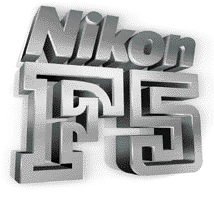 |
| Message Board | for Nikon F5 Series SLR model(s) | |
HOME - Photography in Malaysia |
![]()
A resource dedicated to my kids, Alvin Foo & Esther Foo- one day,
BOTH might need to use all these information for his/her Nikon F5A camera.
Volunteered Maintainer(s) for the Nikon F5 Message Board: Tony Davies-Patrick, UK; Rick Oleson, US; Koh Kho King, Malaysia.
Credit: Mr. Chuck Hester, US for his text re-editing skill for this site; Our staff, HowKiat® who created the 3D-Nikon F5 logo. Mr. Lew Chee Wai of YL camera for lending his F5 for me to take some shots appeared in this site. All those nice folks who have contributed their images, in particular Mr. Mike Long, Edwin leong, Palmi Einarsson, Sergio Pessolano, Fred Kamphues, Harry Eggens, Curtis Forrester, Nick (Natures Moments), Sandra Bartocha; fellow countrymen, Vincent Thian, Koh Kho King, Philip Chong, CY Leow etc. and contributions from a few nice folks from Photo Malaysia Forum. Disclaimers & acknowledgments: Certain content and images appeared in this site were either scanned from official marketing leaflets, brochures published by Nikon and/or contribution from surfers who claimed originality of their own work for public publishing in this website, where majority of the extracted information are used basing on educational merits. The creator of this site will not be responsible for any discrepancies that may arise from any possible dispute except rectifying them after verification from respective source. Neither Nikon or its associates has granted any permission(s) in using their public information nor has any interest in the creation of this site. "Nikon", "Nikkormat", "Nippon Kokagu KK" "Silent Wave", "Focus Tracking Lock-on", "Nikkor" & other applicable technical/business terms are registered trade name(s) of Nikon Corporation Inc., Japan. Site made with an Apple G5 IMac.